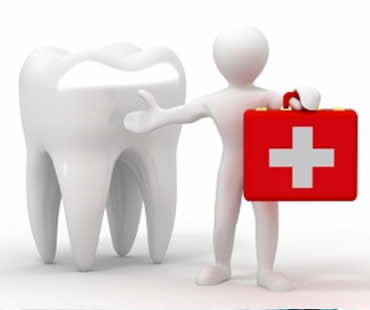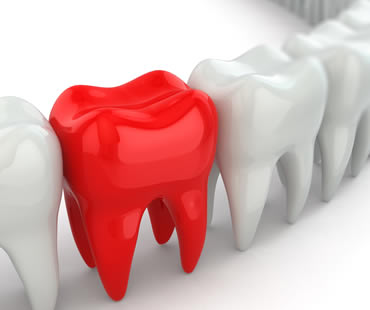
by Dr. Adkins | Jan 2, 2025 | Blog, Dental Topics 2, Emergency Dentistry
Problems with your mouth or teeth can occur suddenly. You might be injured playing a sport, eating, or even just while doing a seemingly harmless activity. You should know what types of dental problems are considered emergencies, and what to do while waiting to see your dentist. Quick action can make a big difference in saving a tooth, or limiting damage to your mouth or face.
What is considered an emergency?
Not every dental problem must be treated as an emergency, but some do require professional treatment as soon as possible. This includes a broken or knocked out tooth, lost crowns and fillings, severe toothache, infection, and injuries to the soft tissues of your mouth.
What should I do?
See your dentist as soon as possible to treat the problem and prevent further damage. Here are some steps to take if you experience any of the following common dental emergencies:
- Severe toothache – rinse your mouth with warm water and floss to remove trapped food.
- Swelling – apply a cold compress on the outside of the swollen area. Do not place any painkiller or aspirin against your gums, because it can burn your gum tissue.
- Chipped or broken tooth – if possible, save the piece that has broken off. Rinse both the piece and your mouth with warm water. If it is bleeding, hold gauze on the area. Apply a cold compress to relieve pain and reduce swelling.
- Lost filling – apply dental cement from your drugstore to fill the hollow area until you can see your dentist. Or, try placing a bit of sugarless gum into the area.
- Lost crown –try to replace the crown on your tooth and hold it in place temporarily with dental cement, denture adhesive, or toothpaste.
- Abscess – infections in your mouth can become abscessed, which is a serious condition. Rinse with warm salt water and see your dentist immediately.
- Soft tissue injuries – treat damage to your gums, cheeks, tongue and lips by rinsing with warm salty water. Hold gauze to the specific area to control bleeding, and hold a cold pack to the external area.
We treat patients from McDonough and the surrounding area

by Dr. Adkins | Nov 21, 2024 | Blog, Dental Topics 2, Emergency Dentistry
Having an accident that involves your teeth can be one of the scariest types of trauma. It’s not only painful, but brings to mind images of a broken or gapped smile. Unfortunately, reports suggest that over half a million people seek treatment in the emergency room each year for dental related issues. Many emergency rooms are not equipped or trained to handle dental problems, so sometimes all you can do is wait to see your dentist.
Since it’s impossible to know exactly when an accident will happen, it’s a good idea to be prepared with items helpful in a dental emergency. Suggested items to include in a dental emergency kit are gauze, Q-tips, salt packets, a small container, over-the-counter pain medication, and sugarless gum. Also include the phone number for your dentist.
If your mouth is damaged in an accident, first rinse your mouth with warm salt water. Follow the directions on the label to take pain medication if necessary. If inner parts of your tooth like the nerves or dentin have been damaged, try covering the area with sugarless gum to protect it until you can get professional treatment.
Sometimes oral injuries can be handled at home until your dentist is available, but more serious situations require seeking care immediately from an emergency dental facility. Some symptoms that usually suggest immediate treatment include facial swelling that is accompanied by a toothache, or uncontrollable bleeding.
If your tooth is knocked out, find it and rinse it with water. Gently try to replace it in the socket. If it can’t be reinserted, place it in a small container with milk or slightly salty water. Ideally, you need to see your dentist within the first couple of hours in order to restore a dislodged tooth.
Following this advice for emergency dental care will help you handle the situation more calmly and know what to do if it happens to you or someone you are with.
We treat patients from McDonough and the surrounding area

by Dr. Adkins | Oct 31, 2024 | Blog, Dental Topics 1, Emergency Dentistry
As much as you hope it doesn’t happen, dental emergencies can sneak up on you. Some clinics offer emergency dental care to provide quick, effective, and safe treatment. It’s important to know what kinds of dental problems require urgent care, as opposed to those that can wait until you can get a regular appointment with your dentist. Here are some common types of emergencies that warrant immediate treatment.
Severe toothache
A painful toothache that won’t go away should not be ignored. These can occur suddenly, be confined to a single area, cause pain when eating, and also involve your gums. Symptoms like these may indicate an abscess, which can also lead to facial swelling. Sometimes your airway can even become blocked. A severe toothache requires immediate relief, and therefore is considered a dental emergency.
Excessive bleeding
If you have oral bleeding from something like losing a tooth and you can’t get it under control, you need to see an emergency dentist. Normally when a tooth falls out, the bleeding will stop after a few minutes. If the blood won’t clot for some reason, or if there was severe trauma, excessive bleeding can occur. A dentist can help stop the bleeding by applying pressure, using a hemostatic agent, or even using stitches.
Fractured teeth
Infection may occur when a tooth is fractured, especially if the break goes deep into a permanent tooth, so immediate care is necessary. An emergency dentist will apply dentine padding to the affected area, so that you can visit your own dentist the next day for further treatment.
Surgery complications
If you have had oral surgery and the pain is more severe or lingering than your dentist anticipated, you should seek treatment immediately to make sure complications like a dry socket or jaw fracture hasn’t occurred.
If you have a dental emergency, contact our McDonough dentists office.

by Dr. Adkins | May 16, 2024 | Blog, Dental Topics 2, Emergency Dentistry
Sometimes an injury or tooth pain can occur suddenly, and immediate dental care may be required. It’s not always obvious when a problem needs emergency care, but some dental emergencies do need to be treated quickly to avoid infections or permanent damage. Here’s a guide to situations that are usually considered dental emergencies.
- Cracked or broken tooth – contact your dentist immediately. Rinse your mouth with water and hold a cold compress to the affected area until you can get to your dentist’s office.
- Excessive bleeding with lip or tongue bite – clean the area and use a cold compress. Go to the emergency room if the bleeding is severe or won’t stop.
- Jaw injury – if you think you may have broken your jaw, apply a cold pack and immediately to your dentist’s office or the emergency room.
- Knocked out tooth –rinse the root of the lost tooth if it’s dirty. Do not scrub or removed any tissue left on the tooth. Try reinserting the tooth into its socket, but if that isn’t successful, see your dentist right away. Placing the lost tooth in milk may help preserve the tooth until you can get professional help.
- Loose tooth – see your dentist immediately if one of your teeth is loosened. Take over-the-counter pain reliever if needed, and apply a cold compress.
- Lost crown or filling – place the crown or filling in a safe place and contact your dentist. To decrease sensitivity, you may apply clove oil and dental cement available at your drugstore, but only if you’ve gotten approval from your dentist.
- Severe or sudden toothache – rinse your mouth with warm water and gently floss around the tooth. Contact your dentist if your toothache persists.
- Swelling – painful swelling in your mouth may indicate an abscess, which is an infected area of pus that can become serious. See your dentist as soon as possible, and try rinsing your mouth with saltwater in the meantime.
We look forward to seeing you in our McDonough dental office

by Dr. Adkins | Apr 18, 2024 | Blog, Dental Topics 1, Emergency Dentistry
It may be obvious when you’re in a situation that requires immediate treatment by a dentist. Perhaps you’re in immense pain, or you’ve had a tooth knocked out or bleeding that won’t stop. Examples like this make it easy to decide you need help right away, but sometimes it’s not as clear. What are some other problems that may require emergency dental treatment?
Cracked teeth
A cracked or fractured tooth is serious, and often means that the tooth has been damaged both on the inside and the outside. Many times the tooth can’t be saved. If your tooth is broken, schedule an emergency appointment immediately. Remember, a cracked tooth is different than a chipped tooth, which is not as serious. You can usually wait to see your dentist at the next available opportunity for a chipped tooth.
Lost fillings
Some lost fillings require immediate care to avoid worse issues. Fillings protect your tooth’s root from exposure, so if the filling falls out your root can be uncovered and cause intense pain. There is also increased risk for damage to your tooth’s structure, so seeing your dentist as soon as possible is suggested.
Lost crown
If your crown falls out, call your dentist for an appointment as soon as possible. Until you can see the dentist, try putting the crown back in place using an over-the-counter dental adhesive. Do not use any products like Super Glue. If the crown won’t stay in place, make sure you take it to your appointment with you so that it can be re-cemented correctly.
Abscess
If you have a painful swelling on your gum that resembles a pimple, it might be a serious condition called an abscess. It can damage gum tissue and teeth, as well as spread serious infection to your body. See your dentist immediately for proper treatment.
Emergency dentist in McDonough – JSA Family Dental Care







 (470) 665-5292
(470) 665-5292  E-Mail Us
E-Mail Us 
